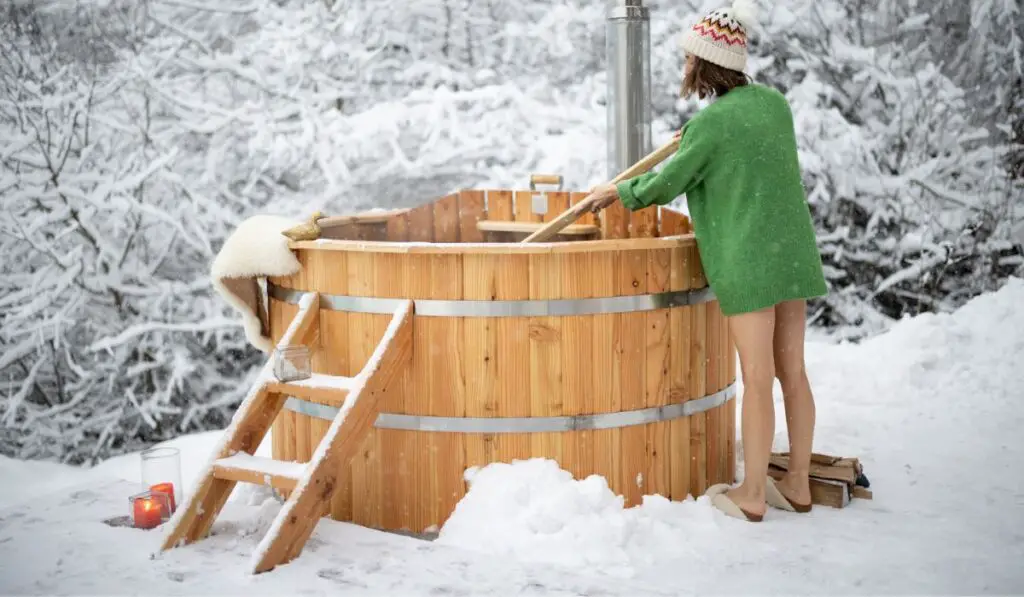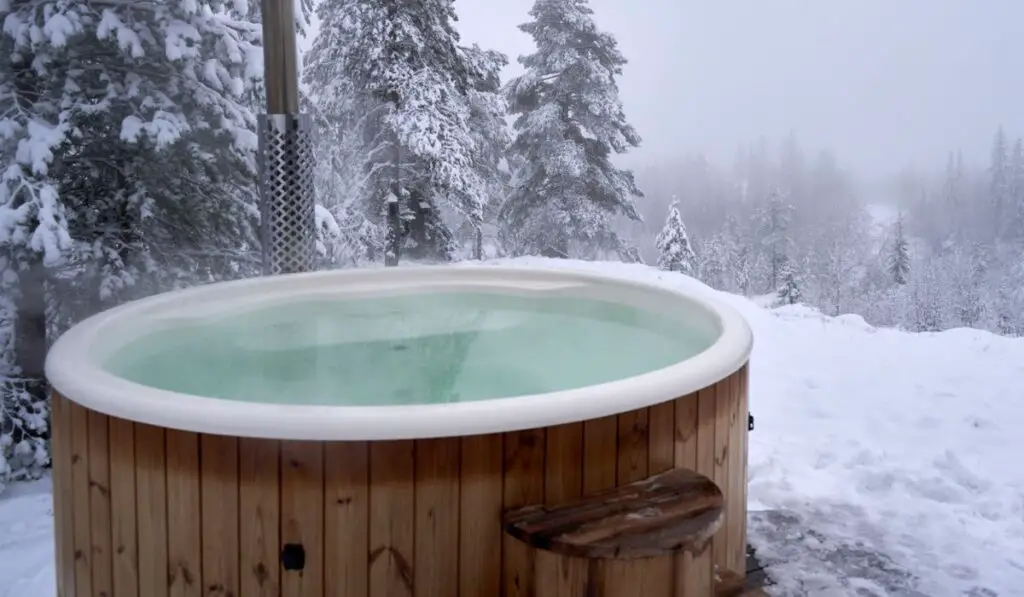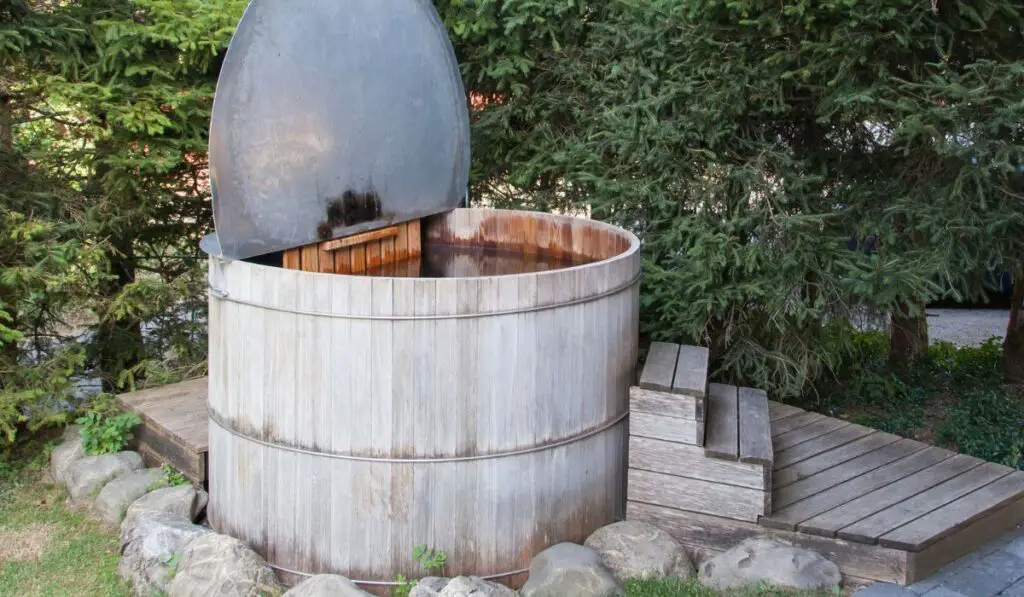One of the perks of owning a hot tub is being able to use it to soak and wind down on a cold winter’s day. But if you’re going out of town or simply won’t use the tub for a couple of months, you might want to winterize it. This can be relatively challenging for new tub owners, so here’s how to go about it:
To winterize a hot tub, allow the chemical levels to drop, then turn off the power and empty the tub. Drain the air blower and pipes, then clean the pipes with a line flush chemical. Take out the filter and clean it. Blow out all remaining water with a shop vac, then clean, dry, and cover the tub.
Winterizing a hot tub may sound tricky, but it’s worth it to keep your tub in tip-top shape through the colder months. Schedule it for the late fall or early winter to avoid damaging your plumbing. Let’s take a closer look at how to proceed so that you can get it right the first time.
How Do You Winterize a Hot Tub?

Generally, winterizing your hot tub involves draining it and ensuring no water is trapped anywhere in the lines.
The next steps are pretty simple, and it’s all a matter of protecting your tub from the elements and any critters that may want to make a winter home of it.
What You’ll Need
You only need a few tools and equipment to winterize your hot tub. Here’s a highlight of the things you require:
- A shop vac with blower capability (on Amazon)
- Garden hose
- Hot tub line flush (on Amazon)
- Drying towels
- Non abrasive sponges
Before you proceed, be sure to check your owner’s manual. While some manufacturers provide detailed instructions for doing the process, others don’t recommend the process at all.
Here’s the general process for safely winterizing your hot tub:
1. Let the Chemicals Dissipate
Before you get to draining your hot tub, it’s best to wait a few days to allow the chemicals in the water to dissipate. These chemicals can be harmful to wildlife in your area.
2. Use a Line Flush Product to Clean the Plumbing
Add a flush line product into your hot tub’s system to flush and clean the plumbing. You need this to prevent mold and algae from blooming during the winter.
You may need to circulate the water for a period ranging from a few minutes to several hours overnight. So be sure to check the instructions for using the line flush product.
While some people may be tempted to use antifreeze, experts advise against it. Antifreeze is usually hard to flush out of the pipes, and you don’t want any of it in your tub while you’re bathing.
3. Turn Off the Power and Drain the Hot Tub
Cut off the power supply to your hot tub by unplugging it from the wall outlet or turning it off from the GFCI breaker. Please confirm the manufacturer’s specifications.
Next, you want to fully drain your hot tub before carrying out any further steps. This can be the most involved part of the winterization process.
Attach a garden hose to the tub’s bottom drain spout and let it empty — it might take about an hour or two. A sump pump will significantly speed up the process, usually getting it down to 10 minutes or less. Ensure the water is draining to a safe area with proper drainage grading.
Remember, the chemicals you use to treat the water, like chlorine, are toxic to plants and animals, so drain in a safe area.
4. Drain the Air Blower
Feel free to skip this step if your hot tub has no air blower. Otherwise, here’s how to drain the blower:
- Carefully disconnect the heater.
- Replace the hot tub’s cover and turn the hot tub back on temporarily.
- Run the air blower for 45 seconds to 1 minute to clear its air channels.
- Turn off the blower, power off the hot tub, and remove the cover.
5. Loosen the Unions & Drain Plugs
Loose the unions or couplers around the pump and heater so you can easily drain any remaining water from the pipes. Let the pipes drain naturally, or use a shop vac to blow them out. Secure the unions and plug the drains once you’ve blown out the pipes.
6. Remove and Clean the Tub’s Filters
Take out your filters and blow them with a shop vac. You then want to store them in a chemical soak to protect them well during the winter. But if you find the filters are severely clogged and damaged, discard them and get ready to buy new ones when you reopen the tub for the season.
7. Remove Any Residual Water With a Shop Vac
Use a shop vac to get rid of any water left in the pipes before proceeding with the final steps. You can unplug the jets and blow them out as well to ensure no moisture remains.
Remember, any water left in the pipes will freeze and expand in the winter months, potentially bursting the pipes and damaging the plumbing system.
8. Thoroughly Clean the Tub’s Shell and Let It Dry
We’re almost done, and here’s where you clean the hot tub’s shell with a non-abrasive sponge and cleaning agent. Rinse it thoroughly and wipe it dry with a soft towel.
You might want to leave a towel at the bottom of the tub to soak up any water that may precipitate in the tub.
9. Clean and Secure the Cover
This is a big one. Use a cover cleaner (on Amazon) that offers reliable mold and mildew protection. When you’re done prepping the cover, replace it over your hot tub and secure it snugly with straps and locks.
10. Inspect the Area Around the Hot Tub
While your tub is now set for the winter, you also want to check the area around it to ensure it’s safe from falling branches, animals, or even the accumulation of ice and snow. You may need extra covering to protect it from objects that could damage it.
Is It Necessary to Winterize Your Hot Tub?

In general, it’s not necessary to winterize a hot tub during the cold months. Provided you leave the tub running, it will keep the water temperature warm, and there won’t be any damage to the pipes. So, if you plan to use your hot tub all winter, leave it on and don’t winterize it.
Modern hot tubs only consume a modest amount of energy to maintain the water temperature. That said, you may only save a minimal amount of money if you turn it off and drain it if you won’t use it over the winter.
Moreover, most people find the winterizing process tedious, since it needs to be done very carefully to protect your plumbing and hot tub’s heating system.
Since water expands when it freezes, any leftover water in your tub can break the piping and force you to deal with high repair costs.
So, if you plan to stay home most of the winter and can check the tub every week or two even if you’re not using it, you could just leave it on. If anything, giving it a winter break won’t extend its life.
Please note, however, that other circumstances may force you to winterize your hot tub. Let’s say you’re going away for more than 2 months, and there won’t be anyone to do basic maintenance. In that case, your best bet is to drain and winterize the tub.
Similarly, if the tub is located somewhere you won’t be using it or be able to do basic maintenance, you’d better prep it for the cold months.
Can You Drain Your Hot Tub for the Winter?
You can drain your hot tub for the winter, although most people prefer to use tubs as usual during the winter. Draining your tub isn’t the best idea because it could make your plumbing lines shrink and leak when you refill the tub.
The one benefit of draining it is that it helps you save on running costs, particularly your energy bills. If you must drain your hot tub for the winter, you need to do so carefully to protect the following parts when the tub is empty:
- The tub’s plumbing
- Pump and filter housings
- The manifold that distributes water to the filter housing
You must thoroughly vacuum the tub, blowing out the pipes and jets to ensure no water remains that could damage them. If you’re not confident in your DIY skills, you might want to hire an experienced plumber or spa professional to do the job.
What Temperature Should Your Hot Tub Be When Not in Use?

It’s a good rule of thumb to keep your hot tub’s temperature about 40˚F below its normal working temperature when you’re not using it. This allows you to quickly reheat the tub and save energy while preventing damage to the heating system.
If you’re going for a vacation and no one else will be using the tub, you can leave it at a safe and warm enough temperature of about 50℉.
Resist the temptation to simply turn off the tub overnight when no one’s using it. While most people think they won’t rack up hefty energy bills this way, it actually increases energy consumption. A hot tub uses more energy to reheat to normal operating temperature.
